lec2-13经典教材《金融时间序列分析》Ruey S. Tsay 英文第三版高清教材以及最新2013年完整版高清讲义
金融时间序列分析英文试题(芝加哥大学) (1)
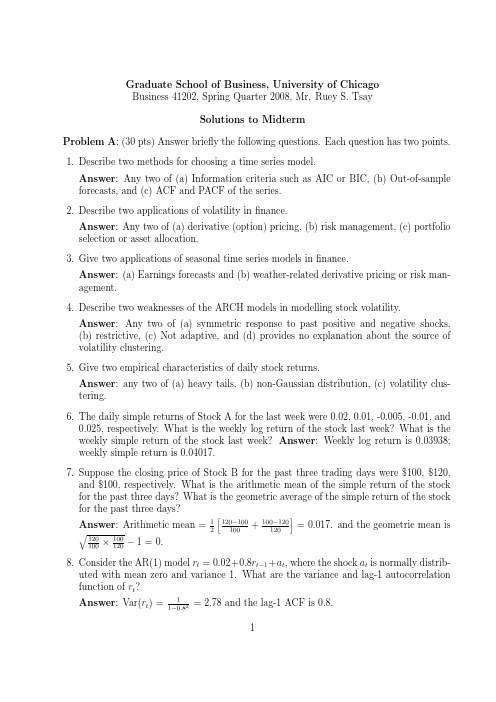
Graduate School of Business,University of ChicagoBusiness41202,Spring Quarter2008,Mr.Ruey S.TsaySolutions to MidtermProblem A:(30pts)Answer briefly the following questions.Each question has two points.1.Describe two methods for choosing a time series model.Answer:Any two of(a)Information criteria such as AIC or BIC,(b)Out-of-sample forecasts,and(c)ACF and PACF of the series.2.Describe two applications of volatility infinance.Answer:Any two of(a)derivative(option)pricing,(b)risk management,(c)portfolio selection or asset allocation.3.Give two applications of seasonal time series models infinance.Answer:(a)Earnings forecasts and(b)weather-related derivative pricing or risk man-agement.4.Describe two weaknesses of the ARCH models in modelling stock volatility.Answer:Any two of(a)symmetric response to past positive and negative shocks,(b)restrictive,(c)Not adaptive,and(d)provides no explanation about the source ofvolatility clustering.5.Give two empirical characteristics of daily stock returns.Answer:any two of(a)heavy tails,(b)non-Gaussian distribution,(c)volatility clus-tering.6.The daily simple returns of Stock A for the last week were0.02,0.01,-0.005,-0.01,and0.025,respectively.What is the weekly log return of the stock last week?What is theweekly simple return of the stock last week?Answer:Weekly log return is0.03938;weekly simple return is0.04017.7.Suppose the closing price of Stock B for the past three trading days were$100,$120,and$100,respectively.What is the arithmetic mean of the simple return of the stock for the past three days?What is the geometric average of the simple return of the stockfor the past three days? Answer:Arithmetic mean=12120−100100+100−120120=0.017.and the geometric mean is120×100−1=0.8.Consider the AR(1)model r t=0.02+0.8r t−1+a t,where the shock a t is normally distrib-uted with mean zero and variance1.What are the variance and lag-1autocorrelation function of r t?Answer:Var(r t)=11−0.82=2.78and the lag-1ACF is0.8.19.For problems6and7,suppose the daily return r t,in percentages,of Stock A followsthe model r t=1.0+a t+0.3a t−1,where a t=σt t withσ2t =1.0+0.4a2t−1and t beingstandard normal.What is the unconditional variance of a t?What is the variance of r t?Answer:Var(a t)=11−0.4=1.67.Var(r t)=(1+0.32)σ2a=1.82.10.Suppose that a n=3.0,what is the1-step ahead forecast for r n+1at the forecast originn?What is the1-step ahead volatility forecast of r t at the forecast origin n?Answer:r n(1)=1+0.3a n=1.9,andσ2n (1)=1+0.4a2n=4.6.11.Consider the simple AR(1)model r t=100+0.8r t−1+a t,where a t is normally distributedwith mean zero and variance10.Is the r t series mean-reverting?If yes,what is the half-life of the series?Answer:Yes,r t series is mean-reverting.The half-life is ln(0.5)/ln(0.8)=3.11.12.Describe two test statistics for testing the ARCH effect of an asset return series.Writedown the associated null hypotheses.Answer:(a)The Ljung-Box statistic Q(m)of the squared shocks,i.e.a2t .The nullhypothesis is H o:ρ1=ρ2=···=ρm=0,whereρi is the lag-i ACF of a2t .(b)TheEngle F-test for the regression a2t =β0+β1a2t−1+···+βm a2t−m+e t.The null hypothesisis H o:β1=β2=···=βm=0.13.Consider the following two IGARCH(1,1)models for percentage log returns:Model A:σ2t =1.0+0.1a2t−1+0.9σ2t−1Model B:σ2t =0.1a2t−1+0.9σ2t−1.Suppose thatσ2100=20and a100=−2.0.What are the3-step ahead volatility forecastsfor Models A and B?Answer:For model A:3-step ahead volatility forecast isσ2100(3)=2+(1.0+0.1×(−2.0)2+0.9×20)=21.4.For model B,the3-step ahead volatility forecast isσ2100(3)=0.1(−2.0)2+0.9×20=18.4.14.Consider the following two models for the log price of an asset:Model A:p t=p t−1+a tModel B:p t=0.00001+p t−1+a twhere the shock a t is normally distributed with mean zero and varianceσ2>0.Suppose further that p100=5.Let p n( )be the -step ahead forecast at the forecast origin n.What are the point forecasts p100( )for both models as →∞?Answer:For model A,p100( )=5for all .For model B,p100( )converges to infinity as →∞.215.Suppose that we have T =1000daily log returns for the Decile 1portfolio.Supposefurther that the sample autocorrelation at lag-12is ˆρ12=0.15.Test the hypothesis H o :ρ12=0against the alternative hypothesis H a :ρ12=pute the test statistic and draw your conclusion.Answer :t =0.151/√1000=√1000×0.15=4.74,which is highly significant.Thus,the lag-12ACF is not zero.Problem B .(20pts)It is well-known in economics that growth rate of the domestic gross product (GDP)is negatively correlated with the change in unemployment rate.Consider the U.S.quarterly real GDP and unemployment rate from the first quarter of 1948to the first quarter of 2008.Let dgdp t be the growth rate of the GDP,i.e.dgdp t =ln(GDP t )−ln(GDP t −1),and dun t be the change in unempolyment rate,i.e.dun t =U t −U t −1with U t being the civilian unemployment rate.The data were seasonally adjusted and obtained from the Federal Reserve Bank at St.Louis.The sample size after the differencing is e the attached R output to answer the following questions.1.(5points)Write down the fitted linear regression model with dgdp t and dun t representing the dependent and independent variable,respectively,including residual standard error.What is the R 2of the linear regression?Is the fitted model adequate?Why?Answer :The fitted linear regression isdgdp t =0.017−0.017dun t +e t ,ˆσe =0.0088.The R 2is 0.37.The model is not adequate because the Q (m )statistics of the residuals show that the residuals have serial correlations,i.e.Q (12)=219.4with p-value close to zero.2.(5points)To take care of the serial correlations in the residuals,a linear regression model with time-series errors is built for the two variables.Write down the fitted model,including the residual variance.Answer :The fitted linear regression model with time-series errors is(1−0.21B −0.12B 2)(1−0.86B 4)(dgdp t −0.017+0.018dun t )=(1−0.72B 4)a t ,ˆσ2a =6.01×10−5.3.(2points)Is the model in Question 2adequate?Why?Answer :Yes,the model is adequate.The Q (m )statistics of the residuals fail to indicate the existence of any serial correlations.We have Q (12)=17.53with p-value 0.13.4.(4points)Based on the fitted model in Question 2,is the growth rate of GDP negatively correlated with the change in unempolyment rate?Why?Answer :Yes,the growth rate of GDP is negatively related to the change in unemploy-ment rate.The estimated coefficient is −0.018which is highly significant,because it standard error 0.0014is small,resulting in a large t -ratio.35.(4points)To check the predictive power of the model,it was re-estimated using thefirst236data points.This re-fitted model is used to produce1-step to4-step ahead forecasts at the forecast origin t=236.The actual value of the GDP growth rates are also given.Construct the1-step ahead95%interval forecast of the model.Is the actual growth rate in the forecasting interval?Answer:The95%interval forecast is0.012±1.96×0.0077,i.e.[−0.0031,0.027].The actual value is0.0159,which is in the interval.Problem C.(16pts)Consider the quarterly earnings per share of the Microsoft stock from thefirst quarter of1992to thefirst quarter of2008.The data were obtained from First Call. To take the log transformation,we add0.5to all data points.The R output is attached. Let x t=ln(y t+0.5)be the transformed earnings,where y t is the actual earnings per share.1.(5points)Write down thefitted model for x t,including the variance of the residuals.Answer:Thefitted model is(1−B)r t=(1−0.70B+0.39B2)(1+0.39B4)a t,ˆσ2a=0.0016, where r t=ln(x t+0.5)with x t being the earnings per share.2.(2points)Is there any significant serial correlation in the residuals of thefitted model?Why?Answer:No,the Q(m)statistics of the residuals give Q(12)=9.65with p-value0.65.3.(4points)Let T=65be the forecast origin,where T is the sample size.Based on thefitted model,and,for simplicity,use the relationship y t=exp(x t)−0.5,what are the 1-step and2-step ahead forecasts of earnings per share for the Microsoft stock?Answer:The1-step and2-step earnings forecasts are0.56and0.54,respectively.4.(2points)Test the null hypothesis H o:θ4=0vs H a:θ4=0.What is the test statistic?Draw your conclusion.Answer:The test statistic is t=0.39120.1442=2.71with two-sided p-value0.0067.Thus,the seasonal MA coefficientθ4is significantly different from zero.5.(3points)Consider the regular(i.e.,non-seasonal)part of the MA model.Is it invertible?Why?Answer:Yes,it is invertible,because the polynomial1−0.6953x+0.3889x2has roots0.89±1.33i so that the absolute value of the roots(Mod in R)is1.6,which is greaterthan1.[If you compute the roots of x2−0.6953x+0.3889,the the absolute value of the roots is less than1.]Problem D.(34pts)Consider the daily log returns of the Starbucks stock,in percentages, from January1993to December2007.The relevant R output is attached.Answer the following questions.41.(2points)Is the mean log return significant different from zero?Why?Answer:No,the basic statistics show the95%confidence interval of the mean is [−0.0103,0.1624],which contains zero.2.(2points)Is there any serial correlation in the log return series?Why?Answer:Yes,the Q(m)statistics show Q(15)=38.39with p-value0.0008.3.(2points)An MA model is used to handle the mean equation,which appears to beadequate.Is there any ARCH effect in the return series?Why?Answer:Yes,because the Q(m)statistics of the squared residuals show Q(15)=112.61 with p-value close to zero.4.(6points)A GARCH(1,1)model with Student-t distribution is used for the volatilityequation.Write down thefitted model,including the degrees of freedom of the Student-t innovations and mean equation.Answer:Thefitted model isr t=0.037+a t−0.043a t−1−0.048a t−2,a t=σt t, ∼t5.27.σ2 t =0.012+0.026a2t−1+0.973σ2t−1.5.(4points)Since the constant term of the GARCH(1,1)model is not significantly differentfrom zero at the1%level,an IGARCH(1,1)model is used.Write down thefitted IGARCH(1,1)model,including the mean equation.Answer:Thefitted IGARCH(1,1)model isr t=0.077+a t−0.029a t−1−0.044a t−2,a t=σt t, t∼N(0,1).σ2 t =0.022a2t−1+0.978σ2t−1.6.(3points)Is the IGARCH(1,1)model adequate?Why?What is the3-step aheadvolatility forecast with the last data point as the forecast origin?Answer:Yes,the Q(m)statistics for the standardized residuals give Q(10)=1.77, Q(15)=10.79,and Q(20)=18.66.The p-values of these statistics are all greater than0.05.In addition,the Q(m)statistics of the squared standardized residuals also havelarge p-values.The3-step ahead volatility forecast is √3.779=1.94.7.(5points)A GJR(or TGARCH)model with Student-t distribution is alsofitted to thelog return series.Write down thefitted model,including the mean equation and all parameters.Answer:Thwfitted GJR model isr t=0.032+a t−0.043a t−1−0.048a t−2,a t=σt t, t∼t5.31.σ2 t =0.015+(0.021+0.017N t−1)a2t−1+0.970σ2t−1,where N t−1=0if a t−1≥0and=1,otherwise.58.(2points)Is the fitted GJR (or TGARCH)model adequate?Why?Answer :Yes,the Q (m )statistics of the standardized residuals and those of the squred standardized residuals all have large p-values.9.(2points)Among the GARCH(1,1),IGARCH(1,1)and GJR(1,1)models,which one is preferred?Why?Answer :The GJR(1,1)model because it has the smallest AIC value.10.(2points)Is the leverage effect of the GJR model significant?Why?Answer :Yes,the t -ratio of the leverage parameter is 2.01,which is significant at the 5%level.11.(4points)To better understand the leverage effect,use the fitted GJR to calculate theratio σ2t (a t −1=−5.10)σ2t(a t −1=5.10),assuming σ2t −1=7.5.Answer :σ2t (a t −1=−5.10)σ2t (a t −1=5.10)=0.0154+0.0379×(−5.10)2+0.97×7.50.0154+0.0208×(5.10)2+0.97×7.5=1.057.6。
《金融时间序列分析》课程教学大纲
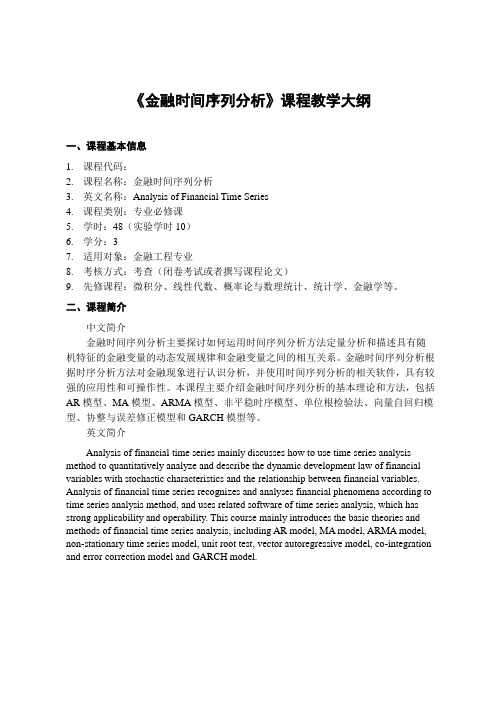
《金融时间序列分析》课程教学大纲一、课程基本信息1.课程代码:2.课程名称:金融时间序列分析3.英文名称:Analysis of Financial Time Series4.课程类别:专业必修课5.学时:48(实验学时10)6.学分:37.适用对象:金融工程专业8.考核方式:考查(闭卷考试或者撰写课程论文)9.先修课程:微积分、线性代数、概率论与数理统计、统计学、金融学等。
二、课程简介中文简介金融时间序列分析主要探讨如何运用时间序列分析方法定量分析和描述具有随机特征的金融变量的动态发展规律和金融变量之间的相互关系。
金融时间序列分析根据时序分析方法对金融现象进行认识分析,并使用时间序列分析的相关软件,具有较强的应用性和可操作性。
本课程主要介绍金融时间序列分析的基本理论和方法,包括AR模型、MA模型、ARMA模型、非平稳时序模型、单位根检验法、向量自回归模型、协整与误差修正模型和GARCH模型等。
英文简介Analysis of financial time series mainly discusses how to use time series analysis method to quantitatively analyze and describe the dynamic development law of financial variables with stochastic characteristics and the relationship between financial variables. Analysis of financial time series recognizes and analyses financial phenomena according to time series analysis method, and uses related software of time series analysis, which has strong applicability and operability. This course mainly introduces the basic theories and methods of financial time series analysis, including AR model, MA model, ARMA model, non-stationary time series model, unit root test, vector autoregressive model, co-integration and error correction model and GARCH model.三、课程性质与教学目的本课程是统计学、应用统计学、数学与应用数学、金融学、投资学与保险学等专业的专业选修课,教学的主要目的在于向学生介绍现代金融时间序列的基础理论、模型和方法,培养学生在经济金融理论的基础上,借助时间序列分析软件建立金融时间序列模型的能力,拓宽学生分析、研究现实经济金融问题的思路,增强学生的数量分析和实际动手能力,从而为对我国金融市场进行实证研究打下坚实基础。
金融时间序列分析教材.pptx

2、模型识别与参数估计
ARMA模型的实证分析
二:ARMA模型实证分析
3、模型建立
Pjt 892.7954 0.5748pj(t 1) 0.4573(t 1) 0.8849(t 2) 0.6281(t 3)
ARMA模型的实证分析
二:ARMA模型实证分析
4、模型检验与预测
k k
1 1 2 1 p p1 2 11 2 p p2 p 1 p1 2 p1 p pk
利用估计的自相关系数,估计出AR(p)参数
ARMA模型的理论介绍
一:ARMA模型的概述
5、如何检验ARMA模型?
检验内容:ARMA(p,q)模型的识别与估计是在假设随机扰动项 t 是一白噪 声基础上进行的,因此,模型检验中首先要检验 t 是不是白噪声 检验指标:Q检验 判断标准:如果残差不存在序列相关,在各阶滞后的自相关和偏自相关值都 接近于零。所有的Q-统计量不显著,并且有大的P值。
X1 X0 1 X2 X1 2 X0 1 2 Xt X0 1 2 t
Xt 称为随机游走序列
Var(Xt ) t 2
X t X t X t1 t Xt 作差分后平稳
ARMA模型的理论介绍
一:ARMA模型的概述
2、滞后算子
滞后算子公式:Ln xt = xt- n
3、自相关函数
对于 Xt 有
6、如何利用ARMA模型进行预测?
设对时间序列样本{xt}, t = 1, 2, …, T,所拟合的模型是 xt = 0.4 xt-1 + 0.77+ 0.68 εt-1
则理论上T + 1期xt的值应按下式计算 xT+1 = 0.4 xT + 0.77 + 0.68 εT
金融专业经典阅读lec2

Modigliani and Miller (1958): Irrelevance Theorem
定理基于一些强假设 ▶ 资本市场交易成本为零 ▶ 个人借款利率与企业借款利率相同,且均无负债风险 ▶ 投资者可按个人意愿进行各种套利活动,不受任何法律限制,且既 不存在企业所得税,也不存在个人所得税 ▶ 企业经营风险相同 ▶ 不同投资者对企业未来收益及风险的预期相同 ▶ 企业增长率为零 ▶ 企业永续经营,且预期各期的现金流量构成等额年金
▶ 管理者的报酬基于 0 期和 1 期的公司价值,γ0 和 γ1 表示权重 ▶ 管理者最大化自己的报酬,通过在 0 期选定负债 F 的规模
信号均衡
▶ 分离均衡,公司 A 的负债比公司 B 的要高,此时市场可以在 0 期 根据负债识别公司类型
▶ 公司 A 通过设定负债规模将其与公司 B 区分开。分离均衡的存在 需要 B 认为混淆视听不值得,对于 B 而言,提高负债规模的成本 比A高
E(θ|e)
−
e L
e H
,低能力的工作者收益为
Spence (1973) 信号
▶ 高能力的人选择的教育水平不会比低能力的人的选择低,为什么?
▶ 假定 H 选择 e,L 选择 e′,则有
E(θ|e)
−
e H
⩾
E(θ|e′)
−
e′ H
E(θ|e′) −
e′ L
⩾
E(θ|e) −
e L
}
=⇒
(e
−
e′)( 1 L
e∗ θ
⩾L
•
e∗
的最大值满足:pH
+
(1
−
p)L
−
e∗ L
⩾L
• e∗ ∈ [0, e3],e3 = pL[H − L]
exam12s经典教材《金融时间序列分析》Ruey S. Tsay 英文第三版2012年试题及答案高清版
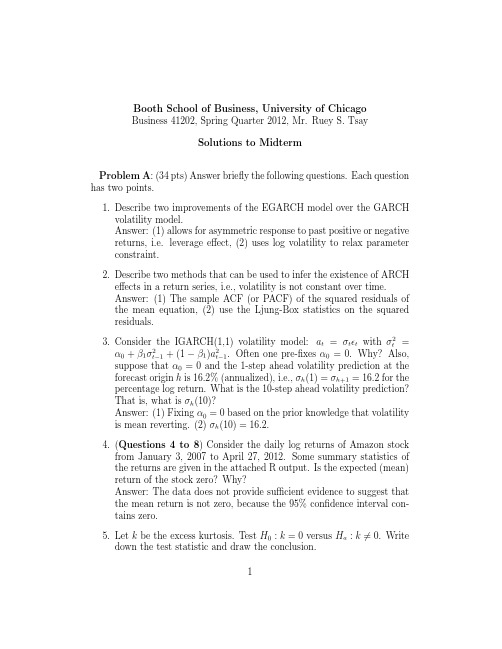
Booth School of Business,University of ChicagoBusiness41202,Spring Quarter2012,Mr.Ruey S.TsaySolutions to MidtermProblem A:(34pts)Answer briefly the following questions.Each question has two points.1.Describe two improvements of the EGARCH model over the GARCHvolatility model.Answer:(1)allows for asymmetric response to past positive or negative returns,i.e.leverage effect,(2)uses log volatility to relax parameter constraint.2.Describe two methods that can be used to infer the existence of ARCHeffects in a return series,i.e.,volatility is not constant over time.Answer:(1)The sample ACF(or PACF)of the squared residuals of the mean equation,(2)use the Ljung-Box statistics on the squared residuals.3.Consider the IGARCH(1,1)volatility model:a t=σt t withσ2t =α0+β1σ2t−1+(1−β1)a2t−1.Often one pre-fixesα0=0.Why?Also,suppose thatα0=0and the1-step ahead volatility prediction at the forecast origin h is16.2%(annualized),i.e.,σh(1)=σh+1=16.2for the percentage log return.What is the10-step ahead volatility prediction?That is,what isσh(10)?Answer:(1)Fixingα0=0based on the prior knowledge that volatility is mean reverting.(2)σh(10)=16.2.4.(Questions4to8)Consider the daily log returns of Amazon stockfrom January3,2007to April27,2012.Some summary statistics of the returns are given in the attached R output.Is the expected(mean) return of the stock zero?Why?Answer:The data does not provide sufficient evidence to suggest that the mean return is not zero,because the95%confidence interval con-tains zero.5.Let k be the excess kurtosis.Test H0:k=0versus H a:k=0.Writedown the test statistic and draw the conclusion.1Answer:t-ratio =9.875√24/1340=73.79,which is highly significant com-pared with χ21distribution.6.Are there serial correlations in the log returns?Why?Answer:No,the Ljung-Box statistic Q (10)=10.69with p-value 0.38.7.Are there ARCH effects in the log return series?Why?Answer:Yes,the Ljung-Box statist of squared residuals gives Q (10)=39.24with p-value less than 0.05.8.Based on the summary statistics provided,what is the 22-step ahead point forecast of the log return at the forecast origin April 27,2012?Why?Answer:The point forecast r T (22)=0because the mean is not signif-icantly different from zero.[Give students 1point if they use sample mean.]9.Give two reasons that explain the existence of serial correlations in ob-served asset returns even if the true returns are not serially correlated.Answer:Any two of (1)bid-ask bounce,(2)nonsynchronous trading,(3)dynamic dependence of volaitlity via risk premuim.10.Give two reasons that may lead to using moving-average models inanalyzing asset returns.Answer:(1)Smoothing (or manipulation),(2)bid-ask bounce in high frequency returns.11.Describe two methods that can be used to compare different modelsfor a given time series.Answer:(1)Information criteria such as AIC or BIC,(2)backtesting or out-of-sample forecasting.12.(Questions 12to 14)Let r t be the daily log returns of Stock A.Assume that r t =0.004+a t ,where a t =σt t with t being iid N(0,1)random variates and σ2t =0.017+0.15a 2t −1.What is the unconditionalvariance of a t ?Answer:Var(a t )=0.0171−0.15=0.02.13.Suppose that the log price at t =100is 3.912.Also,at the forecastorigin t =100,we have a 100=−0.03and σ100=pute the21-step ahead forecast of the log price (not log return)and its volatility for Stock A at the forecast origin t =100.Answer:r 100(1)=0.004so that p 100(1)=3.912+0.004=3.916.Thevolatility forecast is σ2100(1)= 0.017+0.15(−0.03)2=pute the 30-step ahead forecast of the log price and its volatilityof Stock A at the forecast origin t =100.Answer:p 100(30)=3.912+0.004×30=4.032and the voaltility is the unconditional stantard error √0.02=0.141.15.Asset volatility has many applications in finance.Describe two suchapplications.Answer:Any two of (1)pricing derivative,(2)risk management,(3)asset allocation.16.Suppose the log return r t of Stock A follows the model r t =a t ,a t =σt t ,and σ2t =α0+α1a 2t −1+β1σ2t −1,where t are iid N(0,1).Under whatcondition that the kurtosis of r t is 3?That is,state the condition under which the GARCH dynamics fail to generate any additional kurtosis over that of t .Answer:α1=0.17.What is the main consequence in using a linear regression analysis whenthe serial correlations of the residuals are overlooked?Answer:The t -ratios of coefficient estimates are not reliable.Problem B .(30pts)Consider the daily log returns of Amazon stock from January 3,2007to April 27,2012.Several volatility models are fitted to the data and the relevant R output is attached.Answer the following questions.1.(2points)A volatility model,called m1in R,is entertained.Write down the fitted model,including the mean equation.Is the model adequate?Why?Answer:ARCH(1)model.r t =0.0018+a t ,a t =σt t with t being iidN(0,1)and σ2t =7.577×10−4+0.188a 2t −1.The model is inadequatebecause the normality assumption is clearly rejected.2.(3points)Another volatility model,called m2in R,is fitted to the returns.Write down the model,including all estimated parameters.3Answer:ARCH(1)model.r t=4.907×10−4+a t,a t=σt t,where t∼t∗3.56with t∗vdenoting standardized Student-t distribution with v degreesof freedom.The volatility equation isσ2t =7.463×10−4+0.203a2t−1.3.(2points)Based on thefitted model m2,test H0:ν=5versus H a:ν=5,whereνdenotes the degrees of freedom of Student-t distribution.Perform the test and draw a conclusion.Answer:t-ratio=3.562−50.366=−3.93,which compared with1.96is highlysignificant.If you compute the p-value,it is8.53×10−5.Therefore, v=5is rejected.4.(3points)A third model,called m3in R,is also entertained.Writedown the model,including the distributional parameters.Is the model adequate?Why?Answer:Another ARCH(1)model.r t=0.0012+a t,a t=σt t,where t are iid and follow a skew standardized Student-t distribution with skew parameter1.065and degrees of freedom3.591.The volatility equationisσ2t =7.418×10−4+0.208a2t−1.Ecept for the insigicant mean value,thefitted ARCH(1)model appears to be adequate based on the model checking statistics shown.5.(2points)Letξbe the skew parameter in model m3.Does the estimateofξconfirm that the distribution of the log returns is skewed?Why?Perform the test to support your answer.Answer:The t-ratio is1.065−10.039=1.67,which is smaller than1.96.Thus,the null hypothesis of symmetric innovations cannot be rejected at the 5%level.6.(3points)A fourth model,called m4in R,is alsofitted.Write downthefitted model,including the distribution of the innovations.Answer:a GARCH(1,1)model.r t=0.0017+a t,a t=σt t,where t are iid and follow a skew standardized Student-t distribution with skew parameter1.101and degrees of freedom3.71.The volatility equationisσ2t =1.066×10−5+0.0414a2t−1+0.950σ2t−1.7.(2points)Based on model m4,is the distribution of the log returnsskewed?Why?Perform a test to support your answer.Answer:The t-ratio is1.101−10.043=2.349,which is greater than1.96.Thus,the distribution is skew at the5%level.48.(2points)Among models m1,m2,m3,m4,which model is preferred?State the criterion used in your choice.Answer:Model4is preferred as it has a smaller AIC value.9.(2points)Since the estimatesˆα1+ˆβ1is very close to1,we consideran IGARCH(1,1)model.Write down thefitted IGARCH(1,1)model, called m5.Answer:r t=a t,a t=σt t,whereσ2t =3.859×10−5+0.85σ2t−1+0.15a2t−1.10.(2points)Use the IGARCH(1,1)model and the information providedto obtain1-step and2-step ahead predictions for the volatility of the log returns at the forecast origin t=1340.Answer:From the outputσ21340(1)=σ21341=3.859×10−5+0.85×(0.02108)2+0.15(.146)2=0.00361.Therefore,σ21340(2)=3.859×10−5+σ2 1340(1)=0.00365.The volatility forecasts are then0.0601and0.0604,respectively.11.(2points)A GARCH-M model is entertained for the percentage logreturns,called m6in the R output.Based on thefitted model,is the risk premium statistical significant?Why?Answer:The risk premium parameter is−0.112with t-ratio−0.560, which is less than1.96in modulus.Thus,the risk premium is not statistical significant at the5%level.12.(3points)Finally,a GJR-type model is entertained,called m7.Writedown thefitted model,including all parameters.Answer:This is an APARCH model.The model is r t=0.0014+a t,a t=σt t,where t are iid and follow a skew standardized Student-tdistribution with skew parameter1.098and degrees of freedom3.846.The volatility equation isσ2 t =7.583×10−6+0.0362(|a t−1|−0.478a t−1)2+0.953σ2t−1.13.(2points)Based on thefitted GJR-type of model,is the leverage effectsignificant?Why?Answer:Yes,the leverage parameterγ1is signfiicantly different from zero so that there is leverage effect in the log returns.5Problem C.(14pts)Consider the quarterly earnings per share of Abbott Laboratories(ABT)stock from1984.III to2011.III for110observations.We analyzed the logarithms of the earnings.That is,x t=ln(y t),where y t is the quarterly earnings per share.Two models are entertained.1.(3points)Write down the model m1in R,including residual variance.Answer:Let r t be the log earnings per share.Thefitted model is=0.00161.(1−B)(1−B4)r t=(1−0.565B)(1−0.183B4)a t,σ2a2.(2points)Is the model adequate?Why?Answer:No,the Ljung-Box statistics of the residuals give Q(12)=25.76with p-value0.012.3.(3points)Write down thefitted model m2in R,including residualvariance.Answer:Thefitted model is=0.00144.(1−B)(1−B4)r t=(1−0.470B−0.312B3)a t,σ2a4.(2points)Model checking of thefitted model m2is given in Figure1.Is the model adequate?Why?Answer:Yes,the model checking statistics look reasonable.5.(2points)Compare the twofitted model models.Which model ispreferred?Why?Answer:Model2is preferred.It passes model checking and has a smaller AIC value.6.(2points)Compute95%interval forecasts of1-step and2-step aheadlog-earnings at the forecast origin t=110.Answer:1-step ahead prediction:0.375±1.96×0.038,and2-step ahead prediction:0.0188±1.96×0.043.(Some students may use2-step ahead prediction due to the forecast origin confusion.)Problem D.(22pts)Consider the growth rate of the U.S.weekly regular gasoline price from January06,1997to September27,2010.Here growth rate is obtained by differencing the log gasoline price and denoted by gt in R output.The growth rate of weekly crude oil from January03,1997to September24,2010is also obtained and is denoted by pt in R output.Note that the crude oil price was known3days prior to the gasoline price.61.(2points)First,a pure time series model is entertained for the gasolineseries.An AR(5)model is selected.Why?Also,is the mean of the gtseries significantly different from zero?Why?Answer:An AR(5)is selected via the AIC criterion.The mean of g tis not significantly different from zero based on the one-sample t-test.The p-value is0.19.2.(2points)Write down thefitted AR(5)model,called m2,includingresidual variance.Answer:Thefitted model is=0.000326.(1−0.507B−0.079B2−0.136B3+0.036B4+0.086B5)g t=a t,σ2a3.(2points)Since not all estimates of model m2are statistically signifi-cant,we refine the model.Write down the refined model,called m3.Answer:Thefitted model is=0.000327.(1−0.504B−0.074B2−0.122B3+0.101B5)g t=a t,σ2a4.(2points)Is the refined AR(5)model adequate?Why?Answer:Yes,the Ljung-Box statistics of the residuals give Q(14)=10.27with p-value0.74,indicating that there are no serial correlationsin the residuals.5.(2points)Does the gasoline price show certain business-cycle behavior?Why?Answer:Yes,thefitted AR(5)polynomial contains compplex solutions.6.(3points)Next,consider using the information of crude oil price.Writedown the linear regression model,called m4,including R2and residualstandard error.Answer:Thefitted linear regression model isg t=0.287p t+ t,σ =0.0184,and the R2of the regression is33.66%.7.(2points)Is thefitted linear regression model adequate?Why?Answer:No,because the residuals t are serially correlated based onthe Ljung-Box test.78.(3points)A linear regression model with time series errors is enter-tained and insignificant parameters removed.Write down thefinalmodel,including allfitted parameters.Answer:The model is(1−0.404B−0.164B2−0.096B3+0.101B5)(g t−0.191p t)=a t,σ2=0.000253.a9.(2points)Model checking shows that thefittedfinal model has noresidual serial correlations.Based on the model,is crude oil pricehelpful in predicting the gasoline price?Why?Answer:Yes,because thefitted coefficient of p t is signficantly differentfrom zero.10.(2points)Compare the pure time series model and the regression modelwith time-series errors.Which model is preferred?Why?Answer:The regression model with time series error is preferred as ithas a smaller AIC criterion.8。
金融博士书目
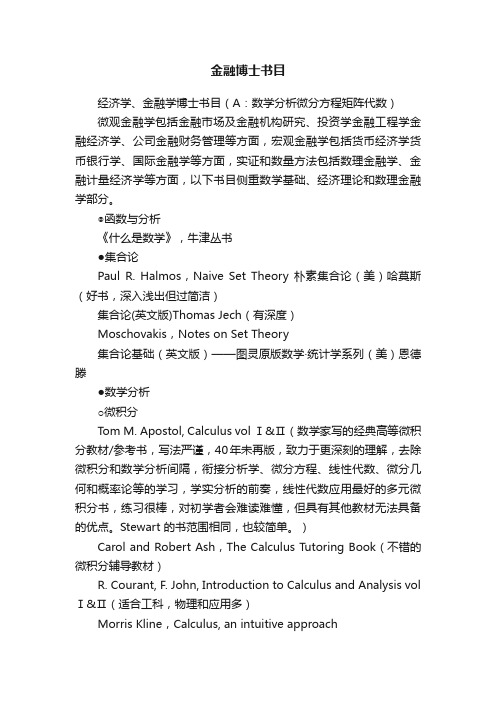
金融博士书目经济学、金融学博士书目(A:数学分析微分方程矩阵代数)微观金融学包括金融市场及金融机构研究、投资学金融工程学金融经济学、公司金融财务管理等方面,宏观金融学包括货币经济学货币银行学、国际金融学等方面,实证和数量方法包括数理金融学、金融计量经济学等方面,以下书目侧重数学基础、经济理论和数理金融学部分。
◎函数与分析《什么是数学》,牛津丛书●集合论Paul R. Halmos,Naive Set Theory 朴素集合论(美)哈莫斯(好书,深入浅出但过简洁)集合论(英文版)Thomas Jech(有深度)Moschovakis,Notes on Set Theory集合论基础(英文版)——图灵原版数学·统计学系列(美)恩德滕●数学分析○微积分Tom M. Apostol, Calculus vol Ⅰ&Ⅱ(数学家写的经典高等微积分教材/参考书,写法严谨,40年未再版,致力于更深刻的理解,去除微积分和数学分析间隔,衔接分析学、微分方程、线性代数、微分几何和概率论等的学习,学实分析的前奏,线性代数应用最好的多元微积分书,练习很棒,对初学者会难读难懂,但具有其他教材无法具备的优点。
Stewart 的书范围相同,也较简单。
)Carol and Robert Ash,The Calculus Tutoring Book(不错的微积分辅导教材)R. Courant, F. John, Introduction to Calculus and Analysis vol Ⅰ&Ⅱ(适合工科,物理和应用多)Morris Kline,Calculus, an intuitive approachRon LarsonCalculus (With Analytic Geometry(微积分入门教材,难得的清晰简化,与Stewart同为流行教材)《高等微积分》Lynn H.Loomis / Shlomo StermbergMorris Kline,Calculus: An Intuitive and Physical Approach (解释清晰的辅导教材)Richard Silverman,Modern Calculus with Analytic GeometryMichael,Spivak,Calculus(有趣味,适合数学系,读完它或者Stewart的就可以读Rudin 的Principles of Mathematical Analysis 或者Marsden的Elementary Classical Analysis,然后读Royden的Real Analysis学勒贝格积分和测度论或者Rudin的Functional Analysis 学习巴拿赫和希尔伯特空间上的算子和谱理论)James Stewart,Calculus(流行教材,适合理科及数学系,可以用Larson书补充,但解释比它略好,如果觉得难就用Larson的吧)Earl W. Swokowski,Cengage Advantage Books: Calculus: The Classic Edition(适合工科)Silvanus P. Thompson,Calculus Made Easy(适合微积分初学者,易读易懂)○实分析(数学本科实变分析水平)(比较静态分析)Understanding Analysis,Stephen Abbott,(实分析入门好书,虽然不面面俱到但清晰简明,Rudin, Bartle, Browder等人毕竟不擅于写入门书,多维讲得少)T. M. Apostol, Mathematical AnalysisProblems in Real Analysis 实分析习题集(美)阿里普兰斯,(美)伯金肖《数学分析》方企勤,北大胡适耕,实变函数《分析学》Elliott H. Lieb / Michael LossH. L. Royden, Real AnalysisW. Rudin, Principles of Mathematical AnalysisElias M.Stein,Rami Shakarchi, Real Analysis:MeasureTheory,Integration and Hilbert Spaces,实分析(英文版) 《数学分析八讲》辛钦《数学分析新讲》张筑生,北大社周民强,实变函数论,北大周民强《数学分析》上海科技社○测度论(与实变分析有重叠)概率与测度论(英文版)(美)阿什(Ash.R.B.),(美)多朗-戴德(Doleans-Dade,C.A.)?Halmos,Measure Theory,测度论(英文版)(德)霍尔姆斯○傅里叶分析(实变分析和小波分析各有一半)小波分析导论(美)崔锦泰H. Davis, Fourier Series and Orthogonal FunctionsFolland,Real Analysis:Modern Techniques and Their ApplicationsFolland,Fourier Analysis and its Applications,数学物理方程:傅里叶分析及其应用(英文版)——时代教育.国外高校优秀教材精选(美)傅兰德傅里叶分析(英文版)——时代教育·国外高校优秀教材精选(美)格拉法科斯B. B. Hubbard, The World According to Wavelets: The Story of a Mathematical Technique in the MakingKatanelson,An Introduction to Harmonic AnalysisR. T. Seeley, An Introduction to Fourier Series and IntegralsStein,Shakarchi,Fourier Analysis:An Introduction○复分析(数学本科复变函数水平)L. V. Ahlfors, Complex Analysis ,复分析——华章数学译丛,(美)阿尔福斯(Ahlfors,L.V.)Brown,Churchill,Complex Variables and Applications Convey, Functions of One Complex Variable Ⅰ&Ⅱ《简明复分析》龚升, 北大社Greene,Krantz,Function Theory of One Complex VariableMarsden,Hoffman,Basic Complex AnalysisPalka,An Introduction to Complex Function TheoryW. Rudin, Real and Complex Analysis 《实分析与复分析》鲁丁(公认标准教材,最好有测度论基础)Siegels,Complex VariablesStein,Shakarchi,Complex Analysis 《复变函数》庄坼泰●泛函分析(资产组合的价值)○基础泛函分析(实变函数、算子理论和小波分析)实变函数与泛函分析基础,程其衰,高教社Friedman,Foundations of Modern Analysis《实变与泛函》胡适耕《泛函分析引论及其应用》克里兹格泛函分析习题集(印)克里希南Problems and methods in analysis,Krysicki夏道行,泛函分析第二教程,高教社夏道行,实变函数与泛函分析《数学分析习题集》谢惠民,高教社泛函分析·第6版(英文版) K.Yosida《泛函分析讲义》张恭庆,北大社○高级泛函分析(算子理论)J.B.Conway, A Course in Functional Analysis,泛函分析教程(英文版)Lax,Functional AnalysisRudin,Functional Analysis,泛函分析(英文版)[美]鲁丁(分布和傅立叶变换经典,要有拓扑基础)Zimmer,Essential Results of Functional Analysis○小波分析Daubeches,Ten Lectures on WaveletsFrazier,An Introduction to Wavelets Throughout Linear Algebra Hernandez,《时间序列的小波方法》PercivalPinsky,Introduction to Fourier Analysis and WaveletsWeiss,A First Course on WaveletsWojtaszczyk,An Mathematical Introduction to Wavelets Analysis●微分方程(期权定价、动态分析)○常微分方程和偏微分方程(微分方程稳定性,最优消费组合)V. I. Arnold, Ordinary Differential Equations,常微分方程(英文版)(现代化,较难)W. F. Boyce, R. C. Diprima, Elementary Differential Equations and Boundary Value Problems《数学物理方程》陈恕行,复旦E. A. Coddington, Theory of ordinary differential equationsA. A. Dezin, Partial differential equationsL. C. Evans, Partial Differential Equations丁同仁《常微分方程教程》高教《常微分方程习题集》菲利波夫,上海科技社G. B. Folland, Introduction to Partial Differential EquationsFritz John, Partial Differential Equations《常微分方程》李勇The Laplace Transform: Theory and Applications,Joel L. Schiff(适合自学)G. Simmons, Differntial Equations With Applications and Historecal Notes索托梅约尔《微分方程定义的曲线》《常微分方程》王高雄,中山大学社《微分方程与边界值问题》Zill○偏微分方程的有限差分方法(期权定价)福西斯,偏微分方程的有限差分方法Kwok,Mathematical Models of Financial Derivatives(有限差分方法美式期权定价)?Wilmott,Dewynne,Howison,The Mathematics of Financial Derivatives (有限差分方法美式期权定价)○统计模拟方法、蒙特卡洛方法Monte Carlo method in finance (美式期权定价)D. Dacunha-Castelle, M. Duflo,Probabilités et Statistiques IIFisherman,Monte Carlo Glasserman,Monte Carlo Mathods in Financial Engineering (金融蒙特卡洛方法的经典书,汇集了各类金融产品)Peter Jaeckel,Monte Carlo Methods in Finance(金融数学好,没Glasserman的好)?D. P. Heyman and M. J. Sobel, editors,Stochastic Models, volume 2 of Handbooks in O. R. and M. S., pages 331-434. Elsevier Science Publishers B.V. (North Holland) Jouini,Option Pricing,Interest Rates and Risk ManagementD. Lamberton, B. Lapeyre, Introduction to Stochastic Calculus Applied to Finance (连续时间)N. Newton,Variance reduction methods for diffusion process :H. Niederreiter,Random Number Generation and Quasi-Monte Carlo Methods. CBMS-NSF Regional Conference Series in Appl. Math. SIAMW.H. Press and al.,Numerical recepies.B.D. Ripley. Stochastic SimulationL.C.G. Rogers et D. Talay, editors,Numerical Methods in Finance. Publicationsof the Newton Institute.D.V. Stroock, S.R.S. Varadhan,Multidimensional diffusion processesD. Talay,Simulation and numerical analysis of stochastic differential systems, a review. In P. Krée and W. Wedig, editors,Probabilistic Methods in Applied Physics, volume 451 of Lecture Notes in Physics, chapter 3, pages 54-96.P.Wilmott and al.,Option Pricing (Mathematical models and computation). Benninga,Czaczkes,Financial Modeling ○数值方法、数值实现方法Numerical Linear Algebra and Its Applications,科学社K. E. Atkinson, An Introduction to Numerical AnalysisR. Burden, J. Faires, Numerical Methods《逼近论教程》CheneyP. Ciarlet, Introduction to Numerical Linear Algebra and Optimisation, Cambridge Texts in Applied MathematicsA. Iserles, A First Course in the Numerical Analysis of Differential Equations, Cambridge Texts in Applied Mathematics 《数值逼近》蒋尔雄《数值分析》李庆杨,清华《数值计算方法》林成森J. Stoer, R. Bulirsch, An Introduction to Numerical AnalysisJ. C. Strikwerda, Finite Difference Schemes and Partial Differential Equations L. Trefethen, D. Bau, Numerical Linear Algebra《数值线性代数》徐树芳,北大其他(不必)《数学建模》Giordano《离散数学及其应用》Rosen《组合数学教程》Van Lint◎几何学和拓扑学(凸集、凹集)●拓扑学○点集拓扑学Munkres,Topology:A First Course《拓扑学》James R.MunkresSpivak,Calculus on Manifolds◎代数学(深于数学系高等代数)(静态均衡分析)○线性代数、矩阵论(资产组合的价值)M. Artin,AlgebraAxler, Linear Algebra Done RightCurtis,Linear Algeria:An Introductory ApproachW. Fleming, Functions of Several VariablesFriedberg, Linear Algebra Hoffman & Kunz, Linear AlgebraP.R. Halmos,Finite-Dimensional Vector Spaces(经典教材,数学专业的线性代数,注意它讲抽象代数结构而不是矩阵计算,难读)J. Hubbard, B. Hubbard, Vector Calculus, Linear Algebra, and Differential Forms: A Unified ApproachN. Jacobson,Basic Algebra Ⅰ&ⅡJain《线性代数》Lang,Undergraduate AlgeriaPeter D. Lax,Linear Algebra and Its Applications(适合数学系)G. Strang, Linear Algebra and its Applications(适合理工科,线性代数最清晰教材,应用讲得很多,他的网上讲座很重要)●经济最优化Dixit,Optimization in Economic Theory●一般均衡Debreu,Theory of Value●分离定理Hildenbrand,Kirman,Equilibrium Analysis(均衡问题一般处理)Magill,Quinzii,Theory of Incomplete Markets(非完备市场的均衡)Mas-Dollel,Whinston,Microeconomic Theory(均衡问题一般处理)Stokey,Lucas,Recursive Methods in Economic Dynamics (一般宏观均衡)经济学、金融学博士书目(B:概率论、数理统计、随机)◎概率统计●概率论(金融产品收益估计、不确定条件下的决策、期权定价)○基础概率理论(数学系概率论水平)《概率论》(三册)复旦Davidson,Stochastic Limit TheoryDurrett,The Essential of Probability,概率论第3版(英文版)W. Feller,An Introduction to Probability Theory and its Applications概率论及其应用(第3版)——图灵数学·统计学丛书《概率论基础》李贤平,高教G. R. Grimmett, D. R. Stirzaker, Probability and Random ProcessesRoss,S. A first couse in probability,中国统计影印版;概率论基础教程(第7版)——图灵数学·统计学丛书(例子多)《概率论》汪仁官,北大王寿仁,概率论基础和随机过程,科学社《概率论》杨振明,南开,科学社○基于测度论的概率论测度论与概率论基础,程式宏,北大D. L. Cohn, Measure TheoryDudley,Real Analysis and ProbabilityDurrett,Probability:Theory and ExamplesJacod,Protter,Probability Essentials Resnick,A Probability PathShirayev,Probability严加安,测度论讲义,科学社钟开莱,A Course in Probability Theory○随机过程微积分Introduction of diffusion processes (期权定价)K. L. Chung, Elementary Probability Theory with Stochastic ProcessesCox,Miller,The Theory of StochasticR. Durrett, Stochastic calculus黄志远,随机分析入门黄志远《随机分析学基础》科学社姜礼尚,期权定价的数学模型和方法,高教社《随机过程导论》KaoKarlin,Taylor,A First Course in Stochastic Prosses(适合硕士生)Karlin,Taylor,A Second Course in Stochastic Prosses(适合硕士生)随机过程,劳斯,中国统计J. R. Norris,Markov Chains(需要一定基础)Bernt Oksendal, Stochastic differential equations(绝佳随机微分方程入门书,专注于布朗运动,比Karatsas和Shreve的书简短好读,最好有概率论基础,看完该书能看懂金融学术文献,金融部分没有Shreve的好)Protter,Stochastic Integration and Differential Equations (文笔优美)D. Revuz, M. Yor, Continuous martingales and Brownian motion(连续鞅)Ross,Introduction to probability model(适合入门)Steel,Stochastic Calculus and Financial Application(与Oksendal的水平相当,侧重金融,叙述有趣味而削弱了学术性,随机微分、鞅)《随机过程通论》王梓坤,北师大○概率论、随机微积分应用(连续时间金融)Arnold,Stochastic Differential Equations《概率论及其在投资、保险、工程中的应用》BeanDamien Lamberton,Bernard Lapeyre. Introduction to stochastic calculus applied t o finance.David Freedman.Browian motion and diffusion.Dykin E. B. Markov Processes.Gihman I.I., Skorohod A. V.The theory of Stochastic processes 基赫曼,随机过程论,科学Lipster R. ,Shiryaev A.N. Statistics of random processes.Malliaris,Brock,Stochastic Methods in Economics and FinanceMerton,Continuous-time FinanceSalih N. Neftci,Introduction to the Mathematics of Financial DerivativesSteven E. Shreve ,Stochastic Calculus for Finance I: The Binomial Asset Pric ing Model;II: Continuous-Time Models(最佳的随机微积分金融(定价理论)入门书,易读的金融工程书,没有测度论基础最初几章会难些,离散时间模型,比Naftci的清晰,S hreve的网上教程也很优秀)Sheryayev A. N. Ottimal stopping rules.Wilmott p., J.Dewynne,S. Howison. Option Pricing: Mathematical Models and Compu tations.Stokey,Lucas,Recursive Methods in Economic Dynamics Wentzell A. D. A Course in the Theory of Stochastic Processes.Ziemba,Vickson,Stochastic Optimization Models in Finance○概率论、随机微积分应用(高级)Nielsen,Pricing and Hedging of Derivative SecuritiesRoss,《数理金融初步》An Introduction to Mathematical Finance:Options and othe r TopicsShimko,Finance in Continuous Time:A Primer○概率论、鞅论P. Billingsley,Probability and MeasureK. L. Chung & R. J. Williams,Introduction to Stochastic IntegrationDoob,Stochastic Processes严加安,随机分析选讲,科学○概率论、鞅论Stochastic processes and derivative products (高级)J. Cox et M. Rubinstein : Options MarketIoannis Karatzas and Steven E. Shreve,Brownian Motion and Stochastic Calculu s(难读的重要的高级随机过程教材,若没有相当数学功底,还是先读Oksendal的吧,结合Rogers & Williams的书读会好些,期权定价,鞅)M. Musiela - M. Rutkowski : (1998) Martingales Methods in Financial Modelling ?Rogers & Williams,Diffusions, Markov Processes, and Martingales: Volume 1, F oundations;Volume 2, Ito Calculus (深入浅出,要会实复分析、马尔可夫链、拉普拉斯转换,特别要读第1卷)David Williams,Probability with Martingales(易读,测度论的鞅论方法入门书,概率论高级教材)○鞅论、随机过程应用Duffie,Rahi,Financial Market Innovation and Security Design:An Introduction,Journal of Economic Theory Kallianpur,Karandikar,Introduction to Option Pricing TheoryDothan,Prices in Financial Markets (离散时间模型)Hunt,Kennedy,Financial Derivatives in Theory and Practice何声武,汪家冈,严加安,半鞅与随机分析,科学社Ingersoll,Theory of Financial Decision MakingElliott Kopp,Mathematics of Financial Markets(连续时间)Marek Musiela,Rutkowski,Martingale Methods in Financial Modeling(资产定价的鞅论方法最佳入门书,读完Hull书后的首选,先读Rogers & Williams、Karatzas and Sh reve以及Bjork打好基础)○弱收敛与随机过程收敛Billingsley,Convergence of Probability MeasureDavidson,Stochastic Limit TheoremEthier,Kurtz,Markov Process:Characterization and Convergence Hall,Marting ale Limit TheoremsJocod,Shereve,Limited Theorems for Stochastic Process Van der Vart,Weller,Weak Convergence and Empirical Process◎运筹学●最优化、博弈论、数学规划○随机控制、最优控制(资产组合构建)Borkar,Optimal control of diffusion processesBensoussan,Lions,Controle Impulsionnel et Inequations Variationnelles Chiang,Elements of Dynamic Optimization Dixit,Pindyck,Investment under UncertaintyFleming,Rishel,Deterministic and Stochastic Optimal ControlHarrison,Brownian Motion and Stochastic Flow SystemsKamien,Schwartz,Dynamic OptimizationKrylov,Controlled diffusion processes○控制论(最优化问题)●数理统计(资产组合决策、风险管理)○基础数理统计(非基于测度论)R. L. Berger, Cassell, Statistical InferenceBickel,Dokosum,Mathematical Stasistics:Basic Ideas andSelected TopicsBirrens,Introdution to the Mathematical and Statistical Foundation of Econom etrics数理统计学讲义,陈家鼎,高教Gallant,An Introduction to Econometric TheoryR. Larsen, M. Mars, An Introduction to Mathematical Statistics《概率论及数理统计》李贤平,复旦社Papoulis,Probability,random vaiables,and stochastic processStone,《概率统计》《概率论及数理统计》中山大学统计系,高教社○基于测度论的数理统计(计量理论研究)Berger,Statistical Decision Theory and Bayesian Analysis陈希儒,高等数理统计Shao Jun,Mathematical StatisticsLehmann,Casella,Theory of Piont EstimationLehmann,Romano,Testing Statistical Hypotheses《数理统计与数据分析》Rice○渐近统计Van der Vart,Asymptotic Statistics○现代统计理论、参数估计方法、非参数统计方法参数计量经济学、半参数计量经济学、自助法计量经济学、经验似然经济学、金融学博士书目(C:计量经济学、数理金融)统计学基础部分1、《统计学》《探索性数据分析》 David Freedman等,中国统计(统计思想讲得好)2、Mind on statistics 机械工业(只需高中数学水平)3、Mathematical Statistics and Data Analysis 机械工业(这本书理念很好,讲了很多新东西)4、Business Statistics a decision making approach 中国统计(实用)5、Understanding Statistics in the behavioral science 中国统计回归部分1、《应用线性回归》中国统计(蓝皮书系列,有一定的深度,非常精彩)2、Regression Analysis by example,(吸引人,推导少)3、《Logistics回归模型——方法与应用》王济川郭志刚高教(不多的国内经典统计教材)多元1、《应用多元分析》王学民上海财大(国内很好的多元统计教材)2、Analyzing Multivariate Data,Lattin等机械工业(直观,对数学要求不高)3、Applied Multivariate Statistical Analysis,Johnson & Wichem,中国统计(评价很高)《应用回归分析和其他多元方法》Kleinbaum《多元数据分析》Lattin时间序列1、《商务和经济预测中的时间序列模型》弗朗西斯著(侧重应用,经典)2、Forecasting and Time Series an applied approach,Bowerman & Connell(主讲Box-Jenkins(ARIMA)方法,附上了SAS和Minitab程序)3、《时间序列分析:预测与控制》 Box,Jenkins 中国统计《预测与时间序列》Bowerman抽样1、《抽样技术》科克伦著(该领域权威,经典的书。
《金融时间序列分析》课程教学大纲
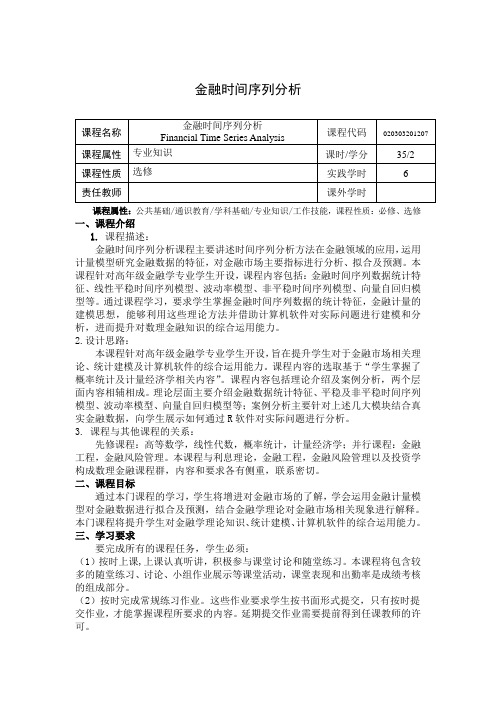
金融时间序列分析课程属性:公共基础/通识教育/学科基础/专业知识/工作技能,课程性质:必修、选修一、课程介绍1.课程描述:金融时间序列分析课程主要讲述时间序列分析方法在金融领域的应用,运用计量模型研究金融数据的特征,对金融市场主要指标进行分析、拟合及预测。
本课程针对高年级金融学专业学生开设,课程内容包括:金融时间序列数据统计特征、线性平稳时间序列模型、波动率模型、非平稳时间序列模型、向量自回归模型等。
通过课程学习,要求学生掌握金融时间序列数据的统计特征,金融计量的建模思想,能够利用这些理论方法并借助计算机软件对实际问题进行建模和分析,进而提升对数理金融知识的综合运用能力。
2.设计思路:本课程针对高年级金融学专业学生开设,旨在提升学生对于金融市场相关理论、统计建模及计算机软件的综合运用能力。
课程内容的选取基于“学生掌握了概率统计及计量经济学相关内容”。
课程内容包括理论介绍及案例分析,两个层面内容相辅相成。
理论层面主要介绍金融数据统计特征、平稳及非平稳时间序列模型、波动率模型、向量自回归模型等;案例分析主要针对上述几大模块结合真实金融数据,向学生展示如何通过R软件对实际问题进行分析。
3. 课程与其他课程的关系:先修课程:高等数学,线性代数,概率统计,计量经济学;并行课程:金融工程,金融风险管理。
本课程与利息理论,金融工程,金融风险管理以及投资学构成数理金融课程群,内容和要求各有侧重,联系密切。
二、课程目标通过本门课程的学习,学生将增进对金融市场的了解,学会运用金融计量模型对金融数据进行拟合及预测,结合金融学理论对金融市场相关现象进行解释。
本门课程将提升学生对金融学理论知识、统计建模、计算机软件的综合运用能力。
三、学习要求要完成所有的课程任务,学生必须:(1)按时上课,上课认真听讲,积极参与课堂讨论和随堂练习。
本课程将包含较多的随堂练习、讨论、小组作业展示等课堂活动,课堂表现和出勤率是成绩考核的组成部分。
《金融时间序列分析》讲稿
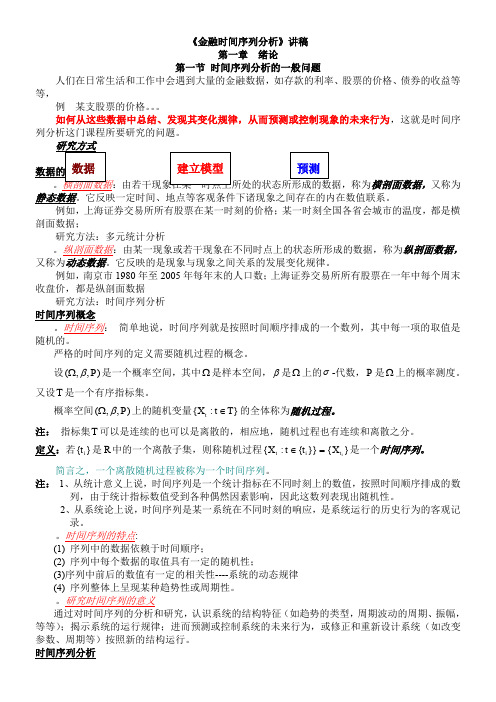
《金融时间序列分析》讲稿第一章 绪论第一节 时间序列分析的一般问题人们在日常生活和工作中会遇到大量的金融数据,如存款的利率、股票的价格、债券的收益等等,例 某支股票的价格。
如何从这些数据中总结、发现其变化规律,从而预测或控制现象的未来行为,这就是时间序列分析这门课程所要研究的问题。
。
横剖面数据:由若干现象在某一时点上所处的状态所形成的数据,称为横剖面数据,又称为静态数据。
它反映一定时间、地点等客观条件下诸现象之间存在的内在数值联系。
例如,上海证券交易所所有股票在某一时刻的价格;某一时刻全国各省会城市的温度,都是横剖面数据;研究方法:多元统计分析。
纵剖面数据:由某一现象或若干现象在不同时点上的状态所形成的数据,称为纵剖面数据,又称为动态数据。
它反映的是现象与现象之间关系的发展变化规律。
例如,南京市1980年至2005年每年末的人口数;上海证券交易所所有股票在一年中每个周末收盘价,都是纵剖面数据研究方法:时间序列分析时间序列概念。
时间序列: 简单地说,时间序列就是按照时间顺序排成的一个数列,其中每一项的取值是随机的。
严格的时间序列的定义需要随机过程的概念。
设),,(P βΩ是一个概率空间,其中Ω是样本空间,β是Ω上的σ-代数,P 是Ω上的概率测度。
又设T 是一个有序指标集。
概率空间),,(P βΩ上的随机变量}:{T t X t ∈的全体称为随机过程。
注: 指标集T 可以是连续的也可以是离散的,相应地,随机过程也有连续和离散之分。
定义:若}{i t 是R 中的一个离散子集,则称随机过程}{}}{:{i t i t X t t X =∈是一个时间序列。
简言之,一个离散随机过程被称为一个时间序列。
注: 1、从统计意义上说,时间序列是一个统计指标在不同时刻上的数值,按照时间顺序排成的数列,由于统计指标数值受到各种偶然因素影响,因此这数列表现出随机性。
2、从系统论上说,时间序列是某一系统在不同时刻的响应,是系统运行的历史行为的客观记录。
金融时间序列分析lec1
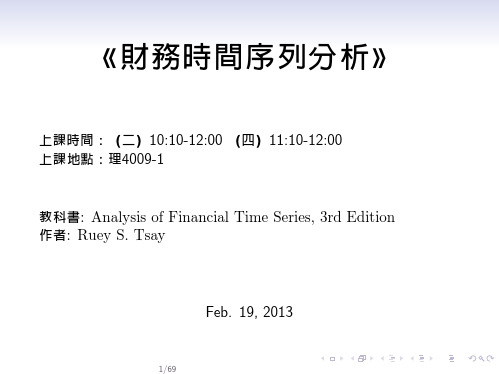
What is the simple return from day 1 to day 2?
38.49−37.84 37.84
Ans R2 =
2
= 0.017. = −0.041.
What is the simple return from day 1 to day 5?
36.30−37.ly interest rates
Relations between the two series? Term structure of interest rates.
Figure: 10 年期及 1 年期的利率:約 12 × 55 筆月資料。
7/69
Exchange rate between US Dollar vs Japanese Yen
Annualized[Rt (k )] =
j =0 k−1
1/k (1 + Rt−j ) −1 ln(1 + Rt−j ) − 1
j =0 k −1
1 = exp k 1 ≈ exp k
k −1
Rt−j − 1 ≈ 1 k
k−1
Rt−j
j =0
j =0
(As x is small, ln(1 + x) ≈ x, exp(x) ≈ 1 + x)
13/69
大部分的財務研究都是探討報酬率 (return) 卻不探討價格的 兩大主因: 1 報酬率提供一般投資者關於投資機會的完整訊息 且報酬率的計算與使用的貨幣無關 (scale-free) 2 報酬率較價格具有較佳的統計性質,E.g. 平穩性
14/69
Asset Returns
Let Pt be the price of an asset at time t, and assume no dividend. One-period simple return
金融时间序列分析—总结

统计学院
整理ppt金融时间序列分析》
3
建模注意要点-2
4、当变量之间存在协整关系时,可以建立ECM进一步考察 短期关系,Eviews这里还提供了一个Wald-Granger检验, 但此时的格兰杰已经不是因果关系检验,而是变量外生性检 验,请注意识别。
5、格兰杰检验只能用于平稳序列!这是格兰杰检验的前提, 而其因果关系并非我们通常理解的因与果的关系,而是说x 的前期变化能有效地解释y的变化,所以称其为“格兰杰原 因”。
第三步,如果变量不仅存在滞后影响,还存在同期影响关系, 则建立VAR模型不太合适,这种情况下需要进行结构分析, 可考虑SVAR模型。
统计学院
整理ppt金融时间序列分性条件,可进行脉冲及
方差分解。注意在做因果检验前要先确定滞后长度,方法见
高铁梅 《计量分析方法与建模 》第2版 P302。
如不满足因果关系,则所有不满足因果关系的变量将视为外
生变量 ,至此要重新构建VAR模型,新的VAR模型将要引
入外生变量的VAR模型(只放在模型右边,不放在左边)
2、当检验的数据是平稳的(即不存在单位根),要想进一 步考察变量的因果联系,可以采用格兰杰因果检验,但要做 格兰杰检验的前提是数据必须是平稳的,否则不能做。(不 是因果关系,看是否有关系,有关系该变量可放入模型)
3、当检验的数据是非平稳(即存在单位根),并且各个序 列是同阶单整(协整检验的前提),想进一步确定变量之间 是否存在协整关系,可以进行协整检验,协整检验主要有 EG两步法和JJ检验:EG两步法是基于回归残差的检验,可 以通过建立OLS模型检验其残差平稳性;JJ检验是基于回归 系数的检验,前提是建立VAR模型(即模型符合ADL模 式)。
如果变量之间不仅存在滞后影响,而且存在同期影响关系, 则适合建立SVAR模型。
最新计量经济学01-概论

2.Walter Enders 著,杜江、谢志超译。《应用计 量经济学》,高等教育出版社,2006。
有价值的参考书(由浅入深)
时间序列著作:有价值的参源自书(由浅入深)1.钱小军等译,《计量经济模型与经济预测》, 机械工业出版社,1999。
2.R S Pindyck and D L Rubinfeld, Econometric models and economic forecasts,影印版,机械 工业出版社,1999。
3.R S Pindyck and D L Rubinfeld, Econometric models and economic forecasts, McGraw-Hill Companies Inc,2000。
有价值的参考书(由浅入深)
计量经济学著作:
1.林少宫译,《计量经济学》,(Gujarati D., Basic Econometrics 第 3 版),中国人民大学出版社, 2000。
2.Basic Econometrics, by Damodar N Gujarati
(Hardcover - Mar 18, 2002) 3.Gujarati D.,著,张涛译,经济计量学精要
3.Time Series Analysis: Forecasting & Control (4rd Edition) by George Box, Gwilym M. Jenkins, Gregory Reinsel,2008。
1. Analysis of financial time series, 2nd edition, by Ruey S. Tsay, John Wiley & Sons. 2005.
时间序列lec9-13
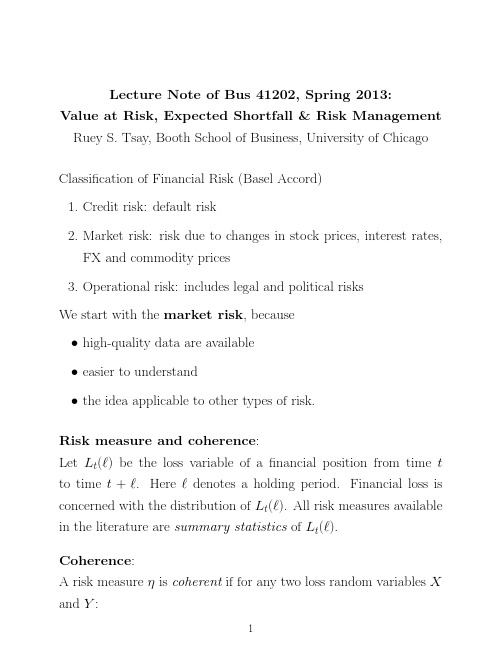
density
0.05
0.10
0.15
0.00
p VaR
−0.05
−5
0 Loss
5
10
Figure 2: Definition of Value at Risk (VaR) for a continuous loss random variable based on the probability density function.
X, if X ≤ 100 0, if X > 100 0, if X ≤ 100 X, if X > 100.
5
and
X2 =
These two loss variables are simply truncated versions of X and we have X = X1 + X2. Since the total probability must be 1, the CDF F 1(X ) of X1 satisfies F 1(80) = 0.9215/0.97 = 0.95 F 1(90) = 0.95/0.97 = 0.9794 F 1(100) = 0.97/0.97 = 1. The 0.95th quantile of X1 is 80. Therefore, VaR1 0.95 = 80, where the superscript 1 is used to denote X1. On the other hand, P r(X2 ≤ 0) = P (X ≤ 100) = 0.97. Therefore, the 0.95th quantile of X2 is less than or equal to 0. We denote this by VaR2 0.95 ≤ 0. Taking the
《时间序列分析》(双语)课程教学大纲
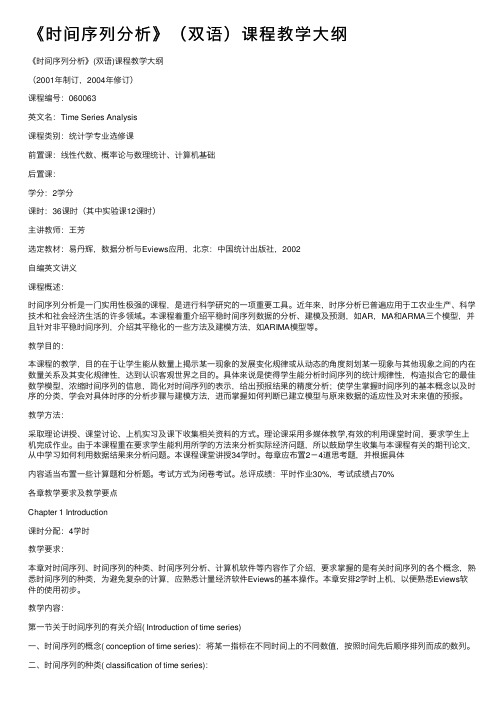
《时间序列分析》(双语)课程教学⼤纲《时间序列分析》(双语)课程教学⼤纲(2001年制订,2004年修订)课程编号:060063英⽂名:Time Series Analysis课程类别:统计学专业选修课前置课:线性代数、概率论与数理统计、计算机基础后置课:学分:2学分课时:36课时(其中实验课12课时)主讲教师:王芳选定教材:易丹辉,数据分析与Eviews应⽤,北京:中国统计出版社,2002⾃编英⽂讲义课程概述:时间序列分析是⼀门实⽤性极强的课程,是进⾏科学研究的⼀项重要⼯具。
近年来,时序分析已普遍应⽤于⼯农业⽣产、科学技术和社会经济⽣活的许多领域。
本课程着重介绍平稳时间序列数据的分析、建模及预测,如AR,MA和ARMA三个模型,并且针对⾮平稳时间序列,介绍其平稳化的⼀些⽅法及建模⽅法,如ARIMA模型等。
教学⽬的:本课程的教学,⽬的在于让学⽣能从数量上揭⽰某⼀现象的发展变化规律或从动态的⾓度刻划某⼀现象与其他现象之间的内在数量关系及其变化规律性,达到认识客观世界之⽬的。
具体来说是使得学⽣能分析时间序列的统计规律性,构造拟合它的最佳数学模型,浓缩时间序列的信息,简化对时间序列的表⽰,给出预报结果的精度分析;使学⽣掌握时间序列的基本概念以及时序的分类,学会对具体时序的分析步骤与建模⽅法,进⽽掌握如何判断已建⽴模型与原来数据的适应性及对未来值的预报。
教学⽅法:采取理论讲授、课堂讨论、上机实习及课下收集相关资料的⽅式。
理论课采⽤多媒体教学,有效的利⽤课堂时间,要求学⽣上机完成作业。
由于本课程重在要求学⽣能利⽤所学的⽅法来分析实际经济问题,所以⿎励学⽣收集与本课程有关的期刊论⽂,从中学习如何利⽤数据结果来分析问题。
本课程课堂讲授34学时。
每章应布置2-4道思考题,并根据具体内容适当布置⼀些计算题和分析题。
考试⽅式为闭卷考试。
总评成绩:平时作业30%,考试成绩占70%各章教学要求及教学要点Chapter 1 Introduction课时分配:4学时教学要求:本章对时间序列、时间序列的种类、时间序列分析、计算机软件等内容作了介绍,要求掌握的是有关时间序列的各个概念,熟悉时间序列的种类,为避免复杂的计算,应熟悉计量经济软件Eviews的基本操作。
金融时间序列分析教材

金融时间序列分析教材金融时间序列分析是金融学中的一个重要领域,它旨在研究金融市场中的时间序列数据,并利用统计模型和方法来预测未来的金融市场走势。
本教材将介绍金融时间序列分析的基本概念、理论框架和常用方法,帮助读者掌握这一领域的基本知识和技能。
第一章介绍了金融时间序列的基本概念和特点。
金融时间序列是指金融市场中某一资产价格(如股票价格、外汇汇率等)或指标随时间变化的一组数据。
它具有时间相关性、波动性和非正态性等特点,需要特殊的方法进行分析和预测。
第二章介绍了金融时间序列的统计特征和描述统计方法。
通过观察和分析时间序列的均值、方差、自相关性和偏度等统计特征,可以揭示时间序列数据中存在的规律和趋势,为后续的分析提供基础。
第三章介绍了平稳时间序列的概念和检验方法。
平稳时间序列是指具有固定的均值和方差,并且其自相关性不随时间变化的时间序列。
通过检验时间序列的平稳性,可以为后续的建模和分析提供准确的结果。
第四章介绍了时间序列数据的建模方法。
包括传统的经典时间序列模型(如AR、MA、ARMA模型)和现代时间序列模型(如ARCH、GARCH、VAR模型)等。
这些模型可以根据时间序列的特点和要求来选择和应用,通过建立合适的模型,对金融时间序列进行预测和分析。
第五章介绍了金融时间序列中的异常值和波动性模型。
在金融市场中,时间序列中常常存在异常波动和极端事件,需要采用特殊的模型(如HAR模型、SV模型)来对其进行建模和分析,以更准确地预测金融市场的波动和风险。
第六章介绍了金融时间序列的预测方法和模型评估。
通过利用已有的时间序列数据,可以采用传统的统计方法(如滚动窗口法、指数平滑法)和机器学习方法(如回归模型、神经网络模型)来进行预测,然后通过模型评估来评估预测的准确性和可靠性。
第七章介绍了金融时间序列的因果关系和协整模型。
通过检验时间序列之间的因果关系和建立协整模型,可以揭示金融市场中不同资产之间的相互影响和长期平衡关系,为投资决策和风险管理提供依据。
金融时间序列 AR Tasy

1.2 Distributional properties of returns
Analysis of Financial Time Series
Fan Qingzhu Peking University
Analysis of Financial Time Series
▪ Financial time series (FTS) analysis is concerned with theory and practice of asset valuation over time. ▪ Comparison with other T.S. analysis? Highly related, but with some added uncertainty. FTS must deal with the ever-changing business & economic environment and the fact that volatility is not directly observed.
▪ Excess return: (adjusting for risk)
▪ where r0t denotes the log return of a reference asset (e.g. risk-free interest rate).
1.1 Asset Returns
▪ Relationship: ▪ If the returns are in percentage, then
Objective of the course
▪ to learn ways to get financial information from web directly and to process the information. ▪ to provide some basic knowledge of financial time series data such as skewness, heavy tails, and measure of dependence between asset returns ▪ to introduce some statistical tools & econometric models useful for analyzing these series. ▪ to gain experience in analyzing FTS
《金融时间序列分析》讲稿

《金融时间序列分析》讲稿第一章 绪论第一节 时间序列分析的一般问题人们在日常生活和工作中会遇到大量的金融数据,如存款的利率、股票的价格、债券的收益等等,例 某支股票的价格。
如何从这些数据中总结、发现其变化规律,从而预测或控制现象的未来行为,这就是时间序列分析这门课程所要研究的问题。
研究方式数据的类型。
横剖面数据:由若干现象在某一时点上所处的状态所形成的数据,称为横剖面数据,又称为静态数据。
它反映一定时间、地点等客观条件下诸现象之间存在的内在数值联系。
例如,上海证券交易所所有股票在某一时刻的价格;某一时刻全国各省会城市的温度,都是横剖面数据;研究方法:多元统计分析。
纵剖面数据:由某一现象或若干现象在不同时点上的状态所形成的数据,称为纵剖面数据,又称为动态数据。
它反映的是现象与现象之间关系的发展变化规律。
例如,南京市1980年至2005年每年末的人口数;上海证券交易所所有股票在一年中每个周末收盘价,都是纵剖面数据研究方法:时间序列分析时间序列概念。
时间序列: 简单地说,时间序列就是按照时间顺序排成的一个数列,其中每一项的取值是随机的。
严格的时间序列的定义需要随机过程的概念。
设),,(P βΩ是一个概率空间,其中Ω是样本空间,β是Ω上的σ-代数,P是Ω上的概率测度。
又设T 是一个有序指标集。
概率空间),,(P βΩ上的随机变量}:{T t X t ∈的全体称为随机过程。
注: 指标集T 可以是连续的也可以是离散的,相应地,随机过程也有连续和离散之分。
定义:若}{i t 是R 中的一个离散子集,则称随机过程}{}}{:{i t i t X t t X =∈是一个时间序列。
简言之,一个离散随机过程被称为一个时间序列。
注: 1、从统计意义上说,时间序列是一个统计指标在不同时刻上的数值,按照时间顺序排成的数列,由于统计指标数值受到各种偶然因素影响,因此这数列表现出随机性。
2、从系统论上说,时间序列是某一系统在不同时刻的响应,是系统运行的历史行为的客观记录。
2020版金融计量学:时间序列分析视角(第三版)教学课件第1章

xy
FX ,Y (x, y;) fx,y (w, z;)dzdw
与联合分布相对的概念是边际分布。 例如,X的边际分布可以通过将联合分 布中与X不相关的赋值设为 来获得:
FX (x;) FX ,Y (x, , , ;)
中国人民银行经作者计算从这几幅图中可以看到不同的金融时间序列变量展示出各种各样的变动轨迹经济学者经常把金融时间序列变量的这种随时间变化的轨迹称为动态路径其中动态一词的含义实质上就是指随时间变化简单净收益率simplenetreturn
金融计量学
第一章 金融计量学初步
1.1 金融计量学的范畴 1.2 金融时间序列数据 1.3 金融计量分析中的基本概念
从具体内容上看,金融计量学涵 盖了宏微观金融理论检验、资本资产 定价、金融变量相关关系的假设检验 、经济状态对金融市场的影响分析以 及金融变量预测等多方面的内容。
1.2 金融时间序列数据 广义地讲,将某种金融随机变量
按出现时间的顺序排列起来称为金融 时间序列。
从现实世界的角度看,金融时间 序列就是指在一定时期内按时间先后 顺序排列的金融随机变量。
1.3.2 随机变量与随机过程 例如: yt c xt t t N (0, 2 )
其中:t N (0, 2 )表示t服从均值为0、 方差为 2的正态分布。注意,在很多教
材中,经常把正态分布也称为高斯分布 (Gaussian distribution)。
随机变量:
yt c xt t , t N (0, 2 )
当X是一个一维的随机变量而不是 向量形式时,边际分布的定义就成为下 面常见的形式:
- 1、下载文档前请自行甄别文档内容的完整性,平台不提供额外的编辑、内容补充、找答案等附加服务。
- 2、"仅部分预览"的文档,不可在线预览部分如存在完整性等问题,可反馈申请退款(可完整预览的文档不适用该条件!)。
- 3、如文档侵犯您的权益,请联系客服反馈,我们会尽快为您处理(人工客服工作时间:9:00-18:30)。
This is called the mean-reversion of the AR(1) process. The variance of forecast error approaches Var[en( )] = 1 2 σ = Var(rt). a 1 − φ2 1
2 σa . 1−φ2 1
k 6. Autocorrelations: ρ1 = φ1, ρ2 = φ2 1 , etc. In general, ρk = φ1
and ACF ρk decays exponentially as k increases, 7. Forecast (minimum squared error): Suppose the forecast origin is n. For simplicity, we shall use the model representation in (1)
4
(g) Behavior of multi-step ahead forecasts. In general, for the -step ahead forecast at n, we have ˆ n ( ) = φ 1 xn , x the forecast error en( ) = an+ + φ1an+ −1 + · · · + φ1−1an+1, and the variance of forecast error Var[en( )] = (1 + φ2 1 + · · · + φ1 In particular, as → ∞, x ˆ n ( ) → 0, i.e., r ˆn( ) → µ.
2 Var[en(2)] = (1 + φ2 1 )σ a
which is greater than or equal to Var[en(1)], implying that uncertainty in forecasts increases as the number of steps increases.
φ0 1−φ1 −φ2
5. Mean-adjusted format: Using φ0 = µ − φ1µ − φ2µ, we can write the AR(2) model as (rt − µ) = φ1(rt−1 − µ) + φ2(rt−2 − µ) + at. This form is often used in the finance literature to highlight the mean-reverting property of a stationary AR(2) model. 6. ACF: ρ0 = 1, ρ1 =
Lecture Notes of Bus 41202 (Spring 2013) Analysis of Financial Time Series Ruey S. Tsay Simple AR models: (Regression with lagged variables.) Motivating example: The growth rate of U.S. quarterly real GNP from 1947 to 1991. Recall that the model discussed before is ˆ a = 0.01. rt = 0.005 + 0.35rt−1 + 0.18rt−2 − 0.14rt−3 + at, σ This is called an AR(3) model because the growth rate rt depends on the growth rates of the past three quarters. How do we specify this model from the data? Is it adequate for the data? What are the implications of the model? These are the questions we shall address in this lecture. Another example: U.S. monthly unemployment rate. AR(1) model: 1. Form: rt = φ0 + φ1rt−1 + at, where φ0 and φ1 are real numbers, which are referred to as “parameters” (to be estimated from the data in an application). For example, rt = 0.005 + 0.2rt−1 + at 2. Stationarity: necessary and sufficient condition |φ1| < 1. Why? 3. Mean: E (rt) =
2 Var[en(1)] = Var(an+1) = σa .
(d) 2-step ahead forecast: ˆn(2) = φ1x ˆn(1) = φ2 x 1 xn . (e) 2-step ahead forecast error: ˆn(2) = an+2 + φ1an+1 en(2) = xn+2 − x (f) Variance of 2-step ahead forecast error:
20
x[1:175]
Figure 2: Various plots of U.S. quarterly growth rate of real GNP: 1947-1991
2
UNRATE
Last 7.7
[1948−01−01/2013−02−01]
10
8
6
4
Jan 1948
Jan 1960
Jan 1970
3
and write xt = rt − µ. The model then becomes xt = φ1xt−1 + at. Note that forecast of rt is simply the forecast of xt plus µ. (a) 1-step ahead forecast at time n: x ˆn(1) = φ1xn (b) 1-step ahead forecast error: ˆn(1) = an+1 en(1) = xn+1 − x Thus, an+1 is the un-predictable part of xn+1. It is the shock at time n + 1! (c) Variance of 1-step ahead forecast error:
5
that the magnitude of the forecast becomes half of that of the forecast origin. For an AR(1) model, this mean 1 x n (k ) = x n . 2
1 Thus, φk 1 xn = 2 xn . Consequently, the half-life of the AR(1) model
is k =
ln(0.5) ln(|φ1 |) .
For example, if φ1 = 0.5, the k = 1. If φ1 = 0.9, then
k ≈ 6.58. AR(2) model: 1. Form: rt = φ0 + φ1rt−1 + φ2rt−2 + at, or (1 − φ1B − φ2B 2)rt = φ0 + at. 2. Stationarity condition: (factor of polynomial) 3. Characteristic equation: (1 − φ1x − φ2x2) = 0 4. Mean: E (rt) =
In practice, it means that for the long-term forecasts serial dependence is not important. The forecast is just the sample mean and the uncertainty is simply the uncertainty about the series. 8. A compact form: (1 − φ1B )rt = φ0 + at. Half-life: A common way to quantify the speed of mean reversion is the half-life, which is defined as the number of periods needed so
Jan 1980
Jan 1990
Jan 2000
Jan 2010
Figure 3: U.S. monthly unemployment rate (total civilian, 16 and older) from January 1948 to February 2013
4. Alternative representation: Let E (rt) = µ be the mean of rt so that µ = φ0/(1 − φ1). Equivalently, φ0 = µ(1 − φ1). Plugging in the model, we have (rt − µ) = φ1(rt−1 − µ) + at. (1)
φ0 1−φ1
1
U.S. quarterly real GNP growth rate: 1947.II to 1991.I
